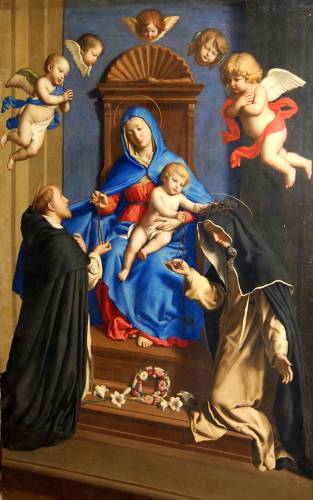
"The traditional image of the Madonna of the Rosary depicts Mary holding the child Jesus in her arm and giving the rosary to St. Dominic. This significant iconography shows that the rosary is a means given by the Virgin for contemplating Jesus and, meditating on his life, for loving and following him always more faithfully." Benedict XVI
The Rosary as a Prayer of Communion
The Rosary is a familiar form of prayer for many Catholics, but it is also a greatly misunderstood prayer as well. Many Non-Catholics believe it is an exercise in mindless repetition or idolatry of Mary. Many Catholics believe that rosary will gain us extra favors or that it can be used as jewelry. Our community has what it refers to as the Precious Blood Rosary as well as what is understood as the more traditional Marian rosary.
The heart of the Rosary is a living relationship with the Lord Jesus and a desire to spend time in his company immersing oneself in the mysteries of his life, death and resurrection. Meditating on these mysteries enables us to remember and to live the heart of the gospel. Knowing these 15 stories, not only with our minds, but with our hearts enables us to walk with Jesus, to pray with him, and to do his will.
The Rosary is essentially a prayer, contemplative prayer. All the emotions of wonder, awe and reverence go with this prayer. All the aims of the ancient practice of Lectio Divina are relevant here. Meditating on the mysteries enables one to “read” the life of Jesus each day. More than reading, meditating on the mysteries in this manner enables one to “chew” the words, to taste them in much the same way as Ezekiel took the scroll on which the Word of God was written and ate it.(1) The use of imagination helps us to enter the story, to hear the voices and to feel the emotions. As the Angel greets Mary in the Annunciation we feel her wonder and doubt. Imagine, the creator of the world being given to you to hold and to care for. Imagine yourself saying “be it done to me according to your word.” Immersing ourselves in the mystery of the Visitation allows us to join in the chorus of “blessed is the fruit of your womb” and to celebrate that “nothing will be impossible for God.”(2)
The praying of the rosary is not about the repetition of many prayers, but a time piece to mark the moment of prayer. Spending time with one another is exactly how a relationship grows and we are drawn into a communion with one another. The prayers we use to mark this prayer experience are fundamentally conversations with the Word of God drawn from the Scripture. The first part of the “Hail Mary” is two passages from the first chapter of Luke’s Gospel. The second part of the “Hail Mary” is the prayer of the church in response. So too, in the rosary we add our own voice, listening to the Word of God and responding from our heart.
The Rosary is an incarnational prayer. The Word was made flesh. In this prayer we use not just mind and heart, but voice and hands as well. In the rosary we are impelled to offer our “bodies as a living sacrifice.”(3) Many of us carry the rosary in our pockets or purses as a reminder, as a tool to carry the prayer with us throughout the day. In this way we follow the command to “pray without ceasing.”(4)
It is through Mary that the Word was made flesh and so in this prayer we also honor the mother of God. She is the one who believed.(5) She is the one who pondered all these things in her heart.(6) She is the one who stood faithfully at the foot of the cross.(7) She is the one given to us to take into our home.(8) For Precious Blood people who remember Gaspars’ devotion to Mary, the Rosary is an important prayer. It is a tool by which we imitate Gaspar who accomplished everything by prayer, we pray with Mary to whom he was so devoted, and we accompany one another in the bond of communion which he so wonderfully preached. Without the correct understanding of Jesus and Mary, without the knowledge of the scripture and the mysteries of the Life of Jesus, the Rosary would be incomprehensible. But with all these things, the Rosary enables us to enter more completely into that intimate communion Jesus established in his own blood.
(1)Ezek 3:3
(2)Luke 1:37
(3)Rom 12:1
(4)1 Thess 5:17, see also Luke 18:1
(5)Luke 1:45
(6)Luke 2:51
(7)John 19:25
(8)John 19:27


Ah! My favorite month.
Well written-a great reminder to realize the meaning and devotion behind prayer (not just a series of words)
So, who is the woman in the painting?
In religious garb (?) getting a crown of thorns (?) from the infant Jesus?
Is that a rosary getting placed in her hand, too?
And by the infant himself, even!
I believe that is Catherine of Siena
According to Sister Mary Mark, it is indeed St. Catherine of Siena. Not sure I get the crown of thorns either. A weird gift to give to ones spouse, but I guess if we could understand it, it wouldn't be God, huh?
Lovely post! I am still in rural - very rural - France with little access to internet. You are very much in my prayer, dear brother. How I wish I could share with you something of what I am being given to live here.